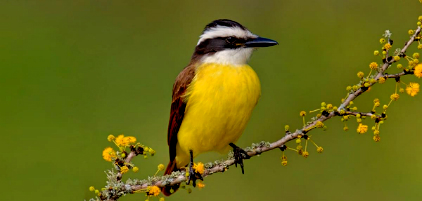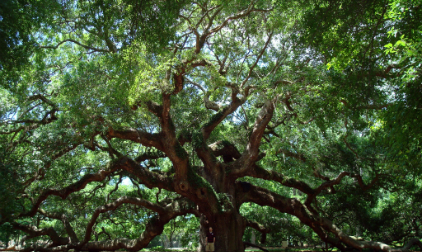
tel. 512 917 4809 Sept 7, 2018
Welcome to the first issue of the Austin Garden. I hope to serve
our vibrant gardening community with articles that inspire and
inform, and help to connect us to the science of gardening, and its
poetry as well. Although this is a new venture, in many ways I am
simply carrying on a newsletter which I edited for It's About
Thyme for many years. (The nursery closed in July.)
However now, rather than promoting one nursery, the Austin Garden
will serve the community, connecting the many tendrils of the gar-
dening scene across the city. A big thank you to Diane and Chris
Winslow for their generous support of this new venture, and to the
Hays Free Press for their sponsorship. - Darrel Mayers (editor)
tel. 512 917 4809 internationalrain@yahoo.com ❦

Three events on Saturday: Visit The Great Outdoors for a garden
party from 11 - 3 p.m. At noon Jimmy Astcio will speak about how
to keep a flock of chickens for fun, food and sustainability. Music
At The Natural Gardener, Linda Wall presents 'Preserving the Harvest,'
a free class at 10 a.m. Learn the basics of freezing, drying and canning.
Attendees receive a coupon good for 20% off any item. (8648 Old Bee
Caves Road 78735)
Farmer as Artist: from 6 p.m. the Prizer Gallery in east Austin offer
a show of paintings, sculpture and photography by local farmers,
including a tribute to Boggy Creek Farm's Larry Butler, painted by
his wife Carol Ann Sayle. (2023 E. Cesar Chavez 78702) ❦

News from Rockport: Diane and Chris Winslow (former owners
of It's About Thyme) reported in this week and want readers to know
that retirement suits them, and that birds are a big part of their life.
Apart from herons, gulls, egrets, and copious amounts of humming-
birds, they have become friends with 'Henry,' a greater kiskadee,
who sits on their heads, shoulders and sometimes even on Diane's
lap to help turn pages of her novel.
While comfortable with retirement, they are both considering diff-
erent activities to fill their time. For Diane it might involve opening
a gift shop/herbarium with a friend. For Chris this might be volun-
teering at Camp Aranzazu, a facility for kids close to their house.
But while they are content in Rockport, they miss the hustle and
bustle of the nursery, their many friends and relatives in Austin. . .
and of course their customers.To all of you, they send their love! ❦
____________________________________________________
The Austin Garden is sponsored by the.Hays Free Press
Central Texas Gardener: After a hot and arid summer, learn how
to boost tired-out soil from Marissa Lankes (ACC). On tour, a visit to

The Glory of Native Oaks
by Chris Winslow
October is one of the best months for planting trees, and since
it is less than a month away, now is a great time to start thinking
about the size and type of tree that would work best in your land-
scape.
Given the current roasting we are having this summer, my mind
at the moment drifts quickly to the shade trees, and my favorite
trees of all time - the oaks.
Planted and watered properly, young trees will grow fast and can
dramatically enhance our landscapes.
Apart from their beauty, there is a practical consideration too. If
you plant them in the right place, shade trees will cool off the air
around your home and help offset costly utility bills.
We have two native Texas oaks that are considered evergreen: the
live oak and the Mexican white oak. Both hold their foliage through-
out the winter months, but then shed their leaves around the end
of February-early March. Spring growth follows in 2 to 3 weeks.
Evergreen oaks are also highly effective as windbreaks and privacy
screens. In addition, when planted on the east, south, and west sides
of a house, they’ll provide you with winter shade.
On the Texas Superstars list and one of my favorite Texas native
shade trees is the Chinquapin oak.
What makes this deciduous shade tree so wonderful is its uncommon
appearance. The leaves can be 6 to 8 inches long and 4 inches wide.
The leaf color is deep green on top with a whitish underside. Un-
like the smooth leaf of the live oak, the Chinquapin’s leaves are
toothed or serrated. Sometimes we call it the ‘Saw Tooth Oak.’
This magnificent shade tree fits so well with the central Texas
climate. It loves the heat and does well in our alkaline soil. It’s
very drought resistant and has few problems with insects and
disease or pests.
Plant your Chinquapin on a well-drained location in full sun or
just a little shade. With infrequent, deep waterings, this beauty
can grow moderately fast, reaching an average height of 40 feet
with an equal spread.
Chinquapin’s fall color is yellow to bronze, making it at top choice
for fall color in the landscape. Their small acorns are loved by birds,
squirrels, deer, and wild turkeys.
For fall color, the Shumards (commonly known as the Texas red
oak) are hard to beat. They carry their brilliant red/orange fall col-
ors throughout November and December, and late trees can hold
these colors even into January.
The stately Bur oak sheds its big leaves without fall color change.
However during the winter months you can enjoy the stark beauty
of their bark and branching structure.
Considered slow growing, the oaks have often been overlooked by
homeowners and property developers in their quest for fast growing
shade trees. People have often made the mistake of choosing soft-
wooded trees like Arizona ash, only to find a few years later that
they are short lived and expensive to remove.
The oaks, however, when planted properly and watered on a regular
basis, can grow as much as 3 feet a year in height and width. That’s
fifteen feet in five years. Now that’s shade!
Happy Gardening Everyone!


